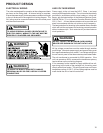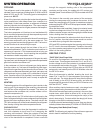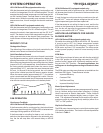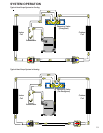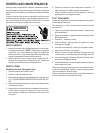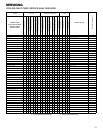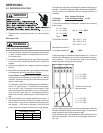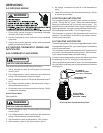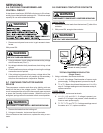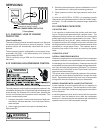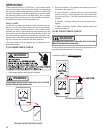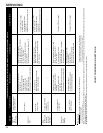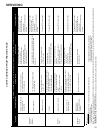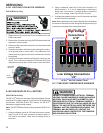
SERVICING
23
S-2 CHECKING WIRING
WARNING
1. Check wiring visually for signs of overheating, damaged
insulation and loose connections.
2. Use an ohmmeter to check continuity of any suspected
open wires.
3. If any wires must be replaced, replace with comparable
gauge and insulation thickness.
S-3 CHECKING THERMOSTAT, WIRING, AND
ANTICIPATOR
S-3A THERMOSTAT AND WIRING
WARNING
LINE VOLTAGE NOW PRESENT.
With power ON and thermostat calling for cooling.
1. Use a voltmeter to verify 24 volts present at thermostat
wires C and R.
2. If no voltage present, check transformer and transformer
wiring. If 24 volts present, proceed to step 3.
3. Use a voltmeter to check for 24 volts at thermostat wires C
and Y.
4. No voltage indicates trouble in the thermostat, wiring or
external transformer source.
5. Check the continuity of the thermostat and wiring. Repair
or replace as necessary.
Indoor Blower Motor
With power ON:
WARNING
LINE VOLTAGE NOW PRESENT.
1. Use a voltmeter to verify 24 volts present at thermostat
wires C and R.
2. If no voltage present, check transformer and transformer
wiring. If 24 volts present, proceed to step 3.
3. Set fan selector switch at thermostat to "ON" position.
4. With voltmeter, check for 24 volts at wires C and G.
5. No voltage, indicates the trouble is in the thermostat or
wiring.
6. Check the continuity of the thermostat and wiring. Repair
or replace as necessary.
S-3B COOLING ANTICIPATOR
The cooling anticipator is a small heater (resistor) in the ther-
mostat. During the "off" cycle it heats the bimetal element
helping the thermostat call for the next cooling cycle. This
prevents the room temperature from rising too high before the
system is restarted. A properly sized anticipator should main-
tain room temperature within 1 1/2 to 2 degree range.
The anticipator is supplied in the thermostat and is not to be
replaced. If the anticipator should fail for any reason, the ther-
mostat must be changed.
S-3C HEATING ANTICIPATOR
The heating anticipator is a wire-wound adjustable heater, which
is energized during the "ON" cycle to help prevent overheating
of the conditioned space.
The anticipator is a part of the thermostat and if it should fail for
any reason, the thermostat must be replaced. See the follow-
ing for recommended heater anticipator setting.
To determine the proper setting, use an amp meter to measure
the amperage on the "W" wire going to the thermostat.
Use an amprobe as shown below. Wrap 10 turns of thermostat
wire around the stationary jaw of the amprobe and divide the
reading by 10.
10 TURNS OF
THERMOSTAT WIRE
(From "W" on thermostat)
STATIONARY JAW
OF AMPROBE
READS 4 AMPS
CURRENT DRAW
WOULD BE .4 AMPS
Checking Heat Anticipator Amp Draw



